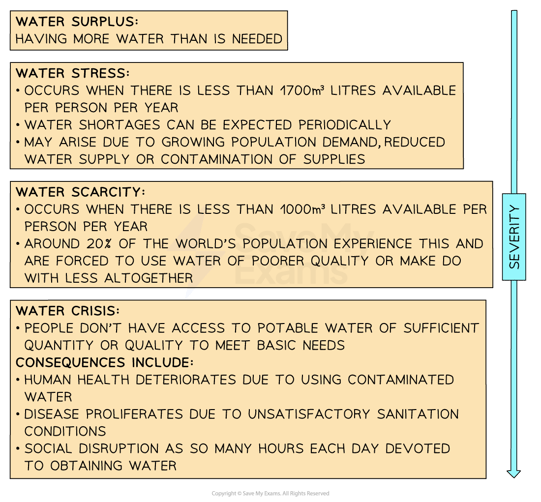Sources of Water
- Achieving water security means trying to obtain and manage sufficient water of a high enough quality to meet current and future needs
- This needs to be done sustainably, so that environmental and local community impacts are minimised
- Only 2.5% of water in the global hydrological cycle is freshwater
- Of that, only 0.9% is easily accessible surface water
- Humans have extracted water from various sources, including rivers, lakes and aquifers
- Technological innovation has seen new sources in the form of the desalination of seawater and recycling
Sources of Water for Human Use
|
Source |
Explanation and Examples |
River abstraction |
Collecting water directly from a river is the oldest method of obtaining water Thames Water which serves London and southeast England gets 70% of its water from rivers |
Reservoirs |
Storage lakes, sometimes natural but often constructed, fed by rivers Welsh Water manages 91 reservoirs and obtains 95% of its water from river abstraction or reservoirs |
Boreholes into the water table |
Wells are sunk through permeable surface layers to penetrate the water table Groundwater is pumped to the surface either with machinery or through natural artesian pressure Thames Water obtains 30% of its water in this way |
Pumping from aquifers |
Aquifers are confined layers of saturated rock, deeper than the water table They are capped top and bottom by impermeable rock When bored into, the substantial pressure it is under forces groundwater to rise The Nubian Sandstone Aquifer System is underneath the eastern end of the Sahara Desert and is an important source of water for Egypt and surrounding countries It contains an estimated 150,000 km3 of groundwater |
Snow and glacier melt |
An important source for irrigation and urban industrial use for countries located near high mountains 60% of Iran’s freshwater comes from its melting glaciers Meltwater from glaciers in the Himalayas feeds the Indus, Ganges and Brahmaputra rivers which are used by 700 million people Climate change is threatening to cut off this source for many regions |
Desalination |
Evaporation of seawater to distil fresh water Requires large amount of energy and produces salt as a by-product 40% of freshwater in Israel is desalinated |
Water recycling and reuse |
The process of treating wastewater using machinery or chemicals so that it can be reused, usually for industrial or agricultural purposes 90% of irrigation in the Valley of Mexico is from recycled water This can also recharge groundwater supplies through percolation |
Exam Tip
This section of the course links to the core topic on water and carbon. If the exam question asks about sources of water, see if you can link your answer to the various key terms in the global hydrological and drainage basin water cycle. For example aquifers are a store of groundwater and are impacted by infiltration and percolation rates





